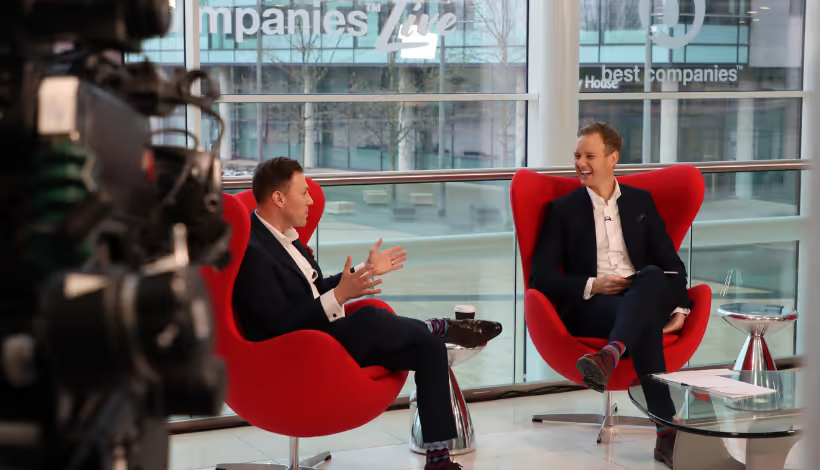
Catch up now

By Andrew Avanessian, CEO at AppLearn
Advocate of employee engagement surveys
In February I appeared on Best Companies Live alongside a panel of other business leaders to discuss how we break down silos within our organisations.
I think it often goes overlooked, but a business that can break down silos and encourage better collaboration can be stronger and more resilient in an ever-changing landscape.
Breaking down silos not only improves business communications and helps us work faster, but it positively impacts the team by bringing people together and developing a sense of belonging. This is really important to us—creating an environment where people can be themselves, be comfortable, and can develop.
For those that are unfamiliar with Best Companies, they are the leading employment engagement specialists, helping organisations identify changes to build a better workplace.
Their live event was hosted by Dan Walker (who has a great eye for good socks... watch the video linked below for context) and was packed with insightful sessions to help organisations improve their culture, better understand their people, be transparent in communications and ultimately lay the foundations for greater success.
The day was a great opportunity to not only share and listen to new ways of working, but also to celebrate success. I think a lot of us are guilty of looking back and highlighting what’s not working, what went wrong, what we could do better. And although that is incredibly important, I think it’s equally important to take a minute and recognise the things you get right.
With the above in mind, I wanted to round up what we discussed on the day, and the things we are doing at AppLearn to break down silos and make us a 3-star accredited Best Company to work for.
So here we go... Or, if you fancy watching the recording, view below.
Long before COVID, we introduced team houses as a way of encouraging cross-departmental interaction. Our team houses are made up of individuals from different departments across the business, regardless of location, and allow employees to interact with others that they don’t typically interact with on a regular basis. It’s great for team building and problem solving. Getting lots of different people together—who have different perspectives—brings new and innovative ways of thinking to the table.
As a software company, we of course had to name our team houses after tech leaders—Lovelace, Gates, Berners-Lee, Wozniak, Babbage, Turing and Hamilton.
The true value of the team houses came to light during the pandemic when they became a go-to way for us to create teams for our virtual events. Supporting each other through COVID gave a social lifeline and brought us all together.
Along with the rest of the world, we worked our way through every virtual event you could think of. Through the Keyhole, Family Fortunes, virtual escape rooms, guess the baby photo competitions, virtual baby showers, and we even created our own ‘pub’—the AppLearn Arms. We distributed Deliveroo vouchers so our team houses could grab lunch, eat ‘together’ and catch up. We hosted walking challenges, Easter egg making classes, cocktail making... you name it, we did it, and all virtually. This helped create that greater feeling of belonging.
With COVID lockdowns a distant memory, we’ve maintained a focus on our team houses and the value they bring to connecting us. When you’re a global business with multiple office locations, it can be hard to build relationships with those you don’t see on a weekly basis.
It’s not uncommon for an organisation to have values, but in many cases, they are forgotten shortly after induction. Unless you live by them—and encourage others to do the same every day—there’s no sugar coating it, values fail.
We didn’t want that, and so, our values are baked into everything we do. They form the basis of our people strategy from hiring and retention, right through to feedback, rewards and recognition.
Our core values follow the acronym AMAZE:
Success happens when everyone is bought in. This is something I am a big believer of.
We have six clear business objectives, each measured by 34 goals. Everyone in the organisation has a role to play in achieving them, regardless of position. Our objectives are communicated regularly to the team and everything we do is built around them.
At AppLearn, everyone knows exactly which objective (and corresponding goal/s) they are responsible for. We not only share objectives and goals at a company-wide level, but we also encourage objectives to be built into team planning and 121s. This removes confusion, promotes clarity, and ensures everyone is moving in the same direction.

A happy team is a fast team. But it’s important to nurture happiness and really understand the needs of the entire team to get this right. Bean bags and free food will only get you so far. You have to build a culture where people can be themselves and can grow.
Our WOW team are a group of individuals that dedicate a portion of their time to continually reviewing and improving our culture. They work to four critical pillars:
If you focus on the above, naturally you create a high-performance culture. But to round things up, I thought it was worth highlighting the nine critical steps we follow to create and maintain our high-performance culture:
Understanding how your employees are thinking and feeling sits at the heart of your engagement journey. Their feedback will drive your decisions, give you areas of focus and help you put plans in place to make improvement happen.
The b-Heard survey is powered by an academically rigorous methodology, and is proven to get to the heart of what people want and expect from their working lives.